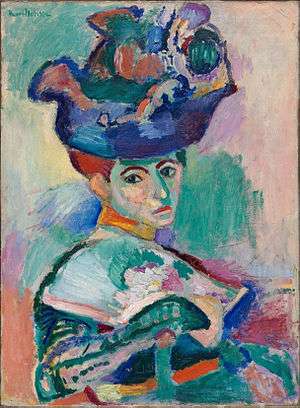André Derain
André Derain (/dəˈræ̃/, French: [ɑ̃dʁe dəʁɛ̃]; 10 June 1880 – 8 September 1954) was a French artist, painter, sculptor and co-founder of Fauvism with Henri Matisse.[1]
André Derain | |
|---|---|
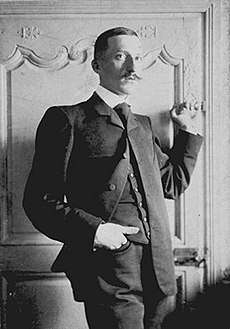 André Derain, 1903 | |
| Born | 10 June 1880 |
| Died | 8 September 1954 (aged 74) Garches, Hauts-de-Seine, Île-de-France, France |
| Education | Académie Camillo, Académie Julian |
| Known for | Painting, sculpture |
| Movement | Fauvism |
Biography
Early years
Derain was born in 1880 in Chatou, Yvelines, Île-de-France, just outside Paris. In 1895 he began to study on his own, contrary to claims that meeting Vlaminck or Matisse began his efforts to paint, and occasionally went to the countryside with an old friend of Cézanne's, Father Jacomin along with his two sons.[2] In 1898, while studying to be an engineer at the Académie Camillo,[3] he attended painting classes under Eugène Carrière, and there met Matisse. In 1900, he met and shared a studio with Maurice de Vlaminck and together they began to paint scenes in the neighbourhood, but this was interrupted by military service at Commercy from September 1901 to 1904.[4] Following his release from service, Matisse persuaded Derain's parents to allow him to abandon his engineering career and devote himself solely to painting; subsequently Derain attended the Académie Julian.[5]
Fauvism
%2C_oil_on_canvas%2C_82_x_101_cm%2C_Pushkin_Museum%2C_Moscow._Exhibited_at_the_1905_Salon_d'Automne.jpg)
Derain and Matisse worked together through the summer of 1905 in the Mediterranean village of Collioure and later that year displayed their highly innovative paintings at the Salon d'Automne. The vivid, unnatural colors led the critic Louis Vauxcelles to derisively dub their works as les Fauves, or "the wild beasts", marking the start of the Fauvist movement.[6] In March 1906, the noted art dealer Ambroise Vollard sent Derain to London to produce a series of paintings with the city as subject. In 30 paintings (29 of which are still extant), Derain presented a portrait of London that was radically different from anything done by previous painters of the city such as Whistler or Monet. With bold colors and compositions, Derain painted multiple pictures of the Thames and Tower Bridge. These London paintings remain among his most popular work. Art critic T. G Rosenthal: "Not since Monet has anyone made London seem so fresh and yet remain quintessentially English. Some of his views of the Thames use the Pointillist technique of multiple dots, although by this time, because the dots have become much larger, it is rather more simply the separation of colours called Divisionism and it is peculiarly effective in conveying the fragmentation of colour in moving water in sunlight."[7]
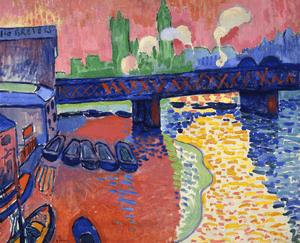
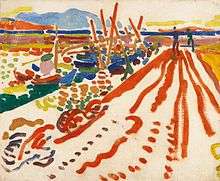
%2C_oil_on_canvas%2C_38_x_46_cm%2C_Mus%C3%A9e_d'Art_Moderne_de_la_Ville_de_Paris.jpg)
In 1907 art dealer Daniel-Henry Kahnweiler purchased Derain's entire studio, granting Derain financial stability. He experimented with stone sculpture and moved to Montmartre to be near his friend Pablo Picasso and other noted artists. Fernande Olivier, Picasso's mistress at the time, described Derain[8] as:
Slim, elegant, with a lively colour and enamelled black hair. With an English chic, somewhat striking. Fancy waistcoats, ties in crude colours, red and green. Always a pipe in his mouth, phlegmatic, mocking, cold, an arguer.
At Montmartre, Derain began to shift from the brilliant Fauvist palette to more muted tones, showing the influence of Cubism and Paul Cézanne.[9] (According to Gertrude Stein, there is a tradition that Derain discovered and was influenced by African sculpture before the Cubists did.[10]) Derain supplied woodcuts in primitivist style for an edition of Guillaume Apollinaire's first book of prose, L'enchanteur pourrissant (1909). He displayed works at the Neue Künstlervereinigung in Munich in 1910,[11] in 1912 at the secessionist Der Blaue Reiter[12] and in 1913 at the seminal Armory Show in New York. He also illustrated a collection of poems by Max Jacob in 1912.
Towards a new classicism
At about this time Derain's work began overtly reflecting his study of the Old Masters. The role of color was reduced and forms became austere; the years 1911–1914 are sometimes referred to as his gothic period. In 1914 he was mobilized for military service in World War I and until his release in 1919 he would have little time for painting, although in 1916 he provided a set of illustrations for André Breton's first book, Mont de Piete.
After the war, Derain won new acclaim as a leader of the renewed classicism then ascendant. With the wildness of his Fauve years far behind, he was admired as an upholder of tradition.[13] In 1919 he designed the ballet La Boutique fantasque for Diaghilev, leader of the Ballets Russes.[14] A major success, it would lead to his creating many ballet designs.
The 1920s marked the height of his success, as he was awarded the Carnegie Prize in 1928 for his Still-life with Dead Game and began to exhibit extensively abroad—in London, Berlin, Frankfurt, Düsseldorf, New York City and Cincinnati, Ohio.[8]
During the German occupation of France in World War II, Derain lived primarily in Paris and was much courted by the Germans because he represented the prestige of French culture. Derain accepted an invitation to make an official visit to Germany in 1941, and traveled with other French artists to Berlin to attend a Nazi exhibition of an officially endorsed artist, Arno Breker.[9] Derain's presence in Germany was used effectively by Nazi propaganda, and after the Liberation he was branded a collaborator and ostracized by many former supporters.[15]
A year before his death, he contracted an eye infection from which he never fully recovered. He died in Garches, Hauts-de-Seine, Île-de-France, France in 1954 when he was struck by a moving vehicle.[16]
Derain's London paintings were the subject of a major exhibition at the Courtauld Institute from 27 October 2005 to 22 January 2006.[17]
Works
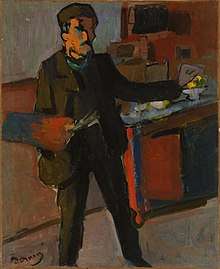 Self-portrait in studio, c.1903, oil on canvas, 42.2 × 34.6 cm, National Gallery of Australia
Self-portrait in studio, c.1903, oil on canvas, 42.2 × 34.6 cm, National Gallery of Australia%2C_oil_on_canvas%2C_54_x_65_cm%2C_Mus%C3%A9e_Cantini%2C_Marseille.jpg) Pinède à Cassis (Landscape), 1907, oil on canvas, 54 × 65 cm, Musée Cantini, Marseille
Pinède à Cassis (Landscape), 1907, oil on canvas, 54 × 65 cm, Musée Cantini, Marseille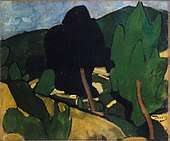 André Derain, 1907, Paysage à Cassis, oil on canvas, 54 × 64 cm, Musée d'art moderne de Troyes
André Derain, 1907, Paysage à Cassis, oil on canvas, 54 × 64 cm, Musée d'art moderne de Troyes_-_Andr%C3%A9_Derain.jpg) Landscape in Provence (Paysage de Provence), c. 1908, oil on canvas, 32.2 × 40.6 cm, Brooklyn Museum, Brooklyn
Landscape in Provence (Paysage de Provence), c. 1908, oil on canvas, 32.2 × 40.6 cm, Brooklyn Museum, Brooklyn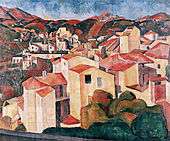 View of Cagnes, 1910, oil on canvas, Museum Folkwang, Essen, Germany
View of Cagnes, 1910, oil on canvas, Museum Folkwang, Essen, Germany%2C_oil_on_canvas%2C_96.5_x_131.1_cm%2C_Metropolitan_Museum_of_Art.jpg) La Table (The Table), 1911, oil on canvas, 96.5 × 131.1 cm, Metropolitan Museum of Art, New York
La Table (The Table), 1911, oil on canvas, 96.5 × 131.1 cm, Metropolitan Museum of Art, New York The Last Supper, 1911, oil on canvas, 227.3 × 288.3 cm, Art Institute of Chicago
The Last Supper, 1911, oil on canvas, 227.3 × 288.3 cm, Art Institute of Chicago%2C_130.8_x_89.5_cm_(51.5_x_35.25_in)%2C_Museum_of_Modern_Art%2C_NY.jpg) Window on the Park (La Fenêtre sur le parc), 1912, oil on canvas, 130.8 × 89.5 cm, Museum of Modern Art
Window on the Park (La Fenêtre sur le parc), 1912, oil on canvas, 130.8 × 89.5 cm, Museum of Modern Art%2C_oil_on_canvas%2C_100.5_x_118_cm%2C_The_State_Hermitage_Museum%2C_Saint_Petersburg%2C_Russia._Reproduced_in_Du_Cubisme%2C_1912.jpg) Nature morte (Still Life), 1912, oil on canvas, 100.5 × 118 cm, The State Hermitage Museum, Saint Petersburg, Russia. Reproduced in Du "Cubisme", 1912
Nature morte (Still Life), 1912, oil on canvas, 100.5 × 118 cm, The State Hermitage Museum, Saint Petersburg, Russia. Reproduced in Du "Cubisme", 1912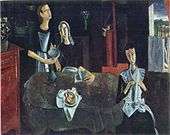 Le Samedi, 1913–14, oil on canvas, 181 × 228 cm, Pushkin Museum, Moscow
Le Samedi, 1913–14, oil on canvas, 181 × 228 cm, Pushkin Museum, Moscow.jpg) Portrait of a Girl in Black, 1913, Hermitage Museum
Portrait of a Girl in Black, 1913, Hermitage Museum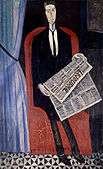 Portrait of a Man with a Newspaper, 1911–1914, Hermitage Museum
Portrait of a Man with a Newspaper, 1911–1914, Hermitage Museum%2C_Nu_debout%2C_limestone%2C_95_x_33_x_17_cm%2C_Mus%C3%A9e_National_d'Art_Moderne.jpg) Nu debout, 1907 (Automne), limestone, 95 x 33 x 17 cm, Musée National d'Art Moderne
Nu debout, 1907 (Automne), limestone, 95 x 33 x 17 cm, Musée National d'Art Moderne%2C_1907.jpg) André Derain, photograph published in Gelett Burgess, "The Wild Men of Paris", Architectural Record, May 1910. Sculpture: Nu debout (Standing Woman), 1907
André Derain, photograph published in Gelett Burgess, "The Wild Men of Paris", Architectural Record, May 1910. Sculpture: Nu debout (Standing Woman), 1907
Public collections
Among the public collections holding works by André Derain are:
References
- Sabine, Rewald. "Fauvism". from Timeline of Art History. New York: The Metropolitan Museum of Art, 2000–. Archived from the original on 14 December 2007. Retrieved 2007-12-17.
- Diehl 1977, p.8
- Cowling and Mundy 1990, p.92
- Diehl 1977 p.14
- "International Painting and Sculpture - Le Cavalier au cheval blanc". National Gallery of Australia. Retrieved 2007-12-17.
- "Gil Blas / dir. A. Dumont". Gallica. 1905-10-17. Retrieved 2020-06-27.
- Tom Rosenthal, reviewing Derain's London paintings on show at the Courtauld Gallery, The Independent 4 December 2005
- Clement 1994, p. 396
- "Works on View: André Derain". Guggenheim Hermitage Museum. Archived from the original on 25 January 2008. Retrieved 2007-12-18.
- "Stein, The Autobiography of Alice B. Toklas".
- Hamilton 1993, p. 207
- Sotriffer 1972, p. 59
- Cowling and Mundy 1990, pp. 92–93
- "Australia Dancing leaps into Trove". Archived from the original on 2011-08-08.
- Dorléac, Laurence Bertrand (2008). Art of the Defeat: France 1940-1944. Los Angeles: Getty Research Institute. pp. 83–87. ISBN 978-0-89236-891-4. Retrieved 14 February 2012.
- "André Derain Biography". Namen der Kunst. Art Directory GmbH. Retrieved 2008-01-03.
- Brettell, Richard R., Paul Hayes Tucker, and Natalie Henderson Lee (2009). The Robert Lehman Collection. III, III. New York, N.Y.: Metropolitan Museum of Art in association with Princeton University Press. p. 253. ISBN 9781588393494.
Further reading
- Clement, Russell (1994). Les Fauves: A Sourcebook. Greenwood Press. ISBN 0-313-28333-8.
- Cowling, Elizabeth; Mundy, Jennifer (1990). On Classic Ground: Picasso, Léger, de Chirico and the New Classicism 1910–1930. London: Tate Gallery. ISBN 1-85437-043-X
- Diehl, Gaston (1977). Derain. Crown Publishers, Inc. ISBN 0517037203.
- Hamilton, George Heard (1993). Painting and Sculpture in Europe, 1880–1940. Yale University Press. ISBN 0300056494.
- Sotriffer, Kristian (1972). Expressionism and Fauvism. McGraw-Hill. OCLC 1149407.
External links
| Wikimedia Commons has media related to André Derain. |
| Wikiquote has quotations related to: André Derain |
- André Derain at the National Gallery of Art
- Works by or about André Derain at Internet Archive
- Works by André Derain (public domain in Canada)
- André Derain exhibition catalogs
- Gelett Burgess, The Wild Men of Paris, Matisse, Picasso and Les Fauves, 1910
- André Derain, Museums and Public Art Galleries Worldwide, Artcyclopedia
- André Derain in American public collections, on the French Sculpture Census website

